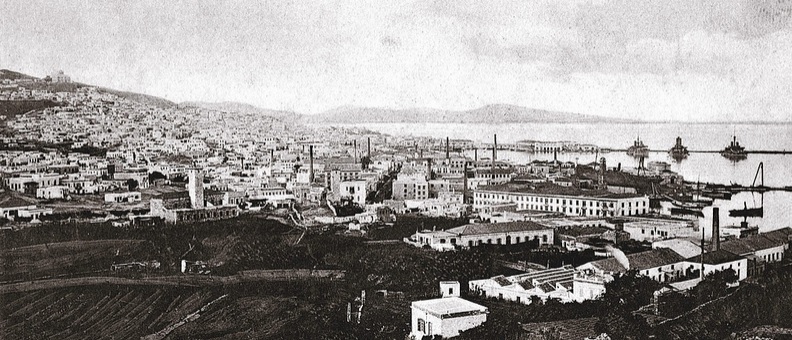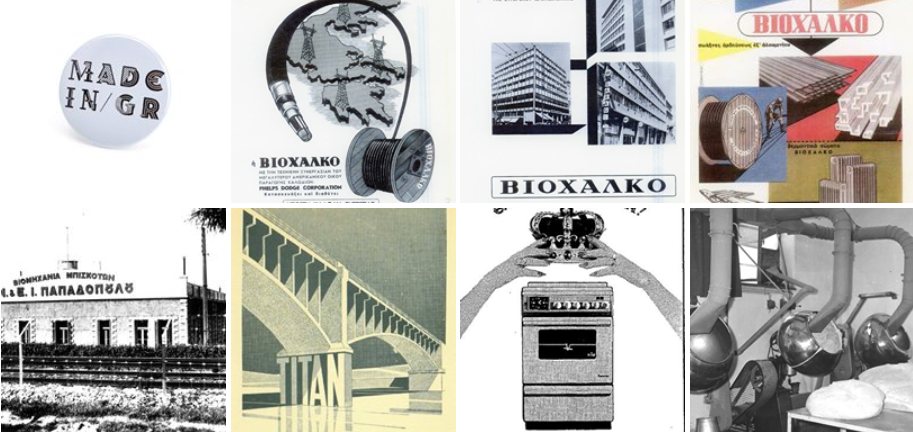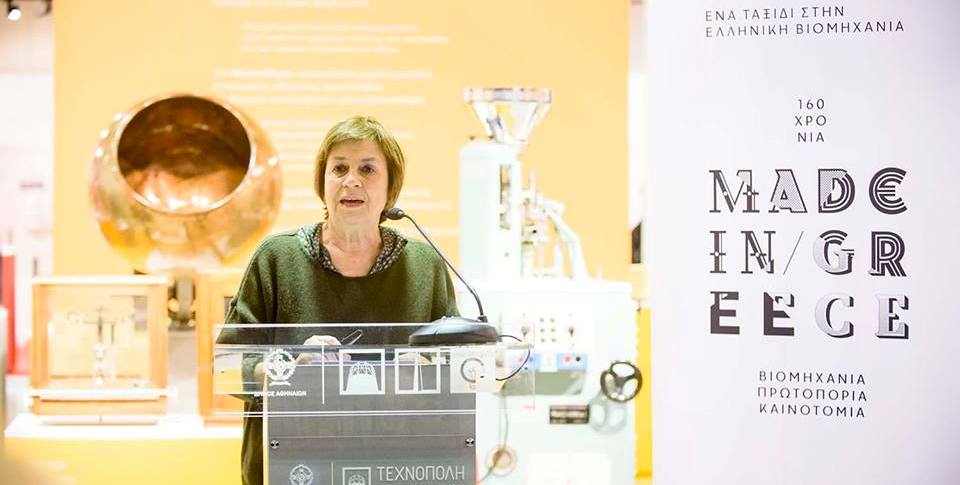To mark 160 years since the opening of the Athens Gasworks factory, Technopolis City of Athens presents a major exhibition chronicling Greece’s industrial development: “160 years made in Greece. Industry, Innovation, Novelty” runs from January 18 until March 25 2018, telling the story -for the first time to that extent- of industrial development in Greece from 1860 until 1970.
The exhibition’s scientific advisor, Christina Agriantoni is Professor Emeritus of the Department of History, Archaeology and Social Anthropology, University of Thessaly (Volos, Greece). Her fields of research are industrial history, urban history, business history and industrial archaeology of Greece and Europe in the 19th and 20th centuries. Her publications include: The Beginnings of Industrialization in Greece (Οι απαρχές της εκβιομηχάνισης στην Ελλάδα τον 19ο αιώνα), Athens, 1986; Syros and Hermoupolis (Σύρος και Ερμούπολη. Συμβολές στην ιστορία του νησιού, 15ος-20ος αι.), National Hellenic Research Foundation, Athens, 2008; and A collective portrait of Greek industrialists (in: Entreprises et Histoire: La Grèce et l’histoire des enterprises, 2011).
Rethinking Greece spoke* with Christina Agriantoni about the Greek industrial sector´s contribution to growth, the waves of industrialization in Greece, the industrial boom of the 50’s and 60’s, Greece’s biggest industries, the process of deindustrialization after the mid 70’s and finally, Greece’s industrial prospects and comparative advantages today. As professor Agriantoni points out: “The history of Greek industry is not known. So we wanted to share this story, show that it had ups and downs like everywhere, and that companies have taken risks and found ways to face the difficulties. […] About 45% of the companies presented in the exhibition are still operating; so the history of the industry in Greece is not over, it does not only belong to the past, but also to the present and to the future.”

The prevailing stereotypes for Greek industrial development are that it was lagging, anemic and its contribution to the economy negligible. Would you like to comment?
There is some truth in these stereotypes, but like all stereotypes, they obscure historical reality. The truth is that Greece has indeed remained a predominantly agricultural country until the Second World War: in 1939 industry’s contribution to GDP was estimated at about 10% and 60% of the population was employed in agriculture (this percentage was 80% in the 19th century). It is also true that Greek industry has always lagged behind the continuous technological progress launched by industrialized countries. All this does not mean that the industry was anemic or unimportant for the economy. It has simply developed according to a different pattern. These stereotypes are due to a long-standing habit of evaluating the industrialization of each country compared to the “first comer” model, namely the British model.
This way of thinking is outdated. Today, we know that each country has experienced its own type of industrialization; in Greece, industrialization is characterized by two main elements: First, it is labor-intensive (as was recently the case in Asian countries), as opposed to the British or American pattern of capital-intensive industrialization. Second, the industry developed in Greece almost exclusively in certain cities –preferably port cities– which formed a kind of enclave, islands of modernity surrounded by a countryside that remained traditional. The differences between cities and countryside (or even between different regions added to the country as its borders progressively expanded) were very marked. Therefore, statistics, in terms of national averages, which are used today to study homogenized and fully urbanized economies, have no sense for earlier times. We must also remember that in each region added to Greece (Thessaly in 1881, Macedonia and Thrace in 1912), the weight of agriculture was even greater than in the territory of the previous frontiers, which re-ruralized, in a way, the country –in terms of national averages.
Finally, it should also be noted that, especially during the inter-war period –when the greatest number of refugees from Asia Minor settled in rural areas– the Greek state systematically pursued a policy favorable to agriculture, in order to ethnically homogenize new territories. This has contributed to the conservation of an overpopulated, feebly productive agricultural sector, with high rates of underemployment.
Industry’s contribution to the economy becomes much more important after the Second World War. It is in fact the industrial sector that leads the economic development of the country, with annual growth rates of 8.6% in 1953-62 and 11.5% in 1963-73, while average GDP growth for the whole period 1953-73 was 6.9%. For example, the share of the broad industrial sector (including construction) in GDP increased from 20% in 1950 to 34.5% in 1973, and that of the processing industry in the strict sense increased from 11,6% to 21% between 1953 and 1973. In contrast, the share of the agricultural sector in GDP decreased from 28% to 15.5%; Greece was no longer an agricultural country.
Which were the most important waves of industrialization in Greece? When did the industry reach its highest point of development and what were the historic conditions that made this possible?
All the waves of industrialization in Greece transpire during periods of enlargement of the internal market, which occurs either because of accelerated urbanization or because of the addition of new territories. This shows that actually, the narrowness of the internal market has been a major impediment to industrial development in Greece (prohibiting, inter alia, mass production), insofar the efforts to orient local industrial production towards exports had failed very early. The waves of industrialization were also part of the phases of expansion of the international economy: Greek economy is sensitive to the fluctuations of international markets, to which it was linked early thanks to its agricultural exports. What is more, in the economy of this small country, foreign trade plays an important role, since internal trade by itself is insufficient as a stimulator of economic activity.

So, Greek industry takes off during 1860-1875, when the mid-century strong growth of the European economy reaches its peak, and the port cities dedicated to foreign trade are thriving. The second wave of industrialization, between 1890 and the eve of the (Balkan and world) wars, is a much bigger one, coming after the marked global economic recovery of the Belle Epoque, but also the first rural exodus in Greece. Then follow the expansion phases of 1918-1921, 1924-1927 and 1933-1939. All these surges are very often curbed by external “accidents”, namely wars, regional crises and the international economic crisis (1929-32).
The prevailing conditions in Greece from the end of the nineteenth century, namely, the relative abundance of labor (decline of the agricultural sector, and then, arrival of refugees from Asia Minor after 1922) and a relatively protected internal market, first by the devaluation of the drachma (1890-1905) and then by tariffs, have shaped in a lasting way the face of industry: labor intensive, small, non-competitive, paying low wages and addressing the domestic consumer market. Still, larger, better organized and technologically advanced companies, were not lacking, but they were the minority. The peculiarity of this dualist structure of Greek industry –a structure that is found in other countries too– was that it leaned heavily on “small” industry (artisan stores or small factories) throughout the inter-war period.
1950-1975: The biggest wave
The biggest and most sustained wave of industrialization in Greece undoubtedly occurred in 1950-1975. First and foremost, this is a long period of peace and stability that follows a period of war, once again prolonged in Greece (Civil War, 1946-49). It is also a period of very marked global growth (the postwar economic boom). In Greece, reconstruction and very rapid urbanization (the countryside is emptying for the first time) have certainly favored industrial development, as well as the expansion of infrastructure (including the national electricity network) financed in part by the Marshall Plan. The 1953 currency reform ensured monetary stabilization, a beneficial factor for the economy as a whole.
 Lastly, and perhaps most importantly, it was the first time that a coherent industrial policy had been applied in the context of a mixed economy, with marked state interventionism, as was the case in all industrial countries around the world at that time. This policy included (1) a series of measures aimed at the motivation of investments and especially at the attraction of foreign capital, (2) the creation of public bodies dedicated to the support of industry and the direct participation of the State in some companies, (3) the obligation on banks to dedicate some of their resources to the financing of industry, and eventually the creation of a bank specialized in long-term industrial credit, and finally (4) the indexation of wages to the evolution of productivity.
Lastly, and perhaps most importantly, it was the first time that a coherent industrial policy had been applied in the context of a mixed economy, with marked state interventionism, as was the case in all industrial countries around the world at that time. This policy included (1) a series of measures aimed at the motivation of investments and especially at the attraction of foreign capital, (2) the creation of public bodies dedicated to the support of industry and the direct participation of the State in some companies, (3) the obligation on banks to dedicate some of their resources to the financing of industry, and eventually the creation of a bank specialized in long-term industrial credit, and finally (4) the indexation of wages to the evolution of productivity.
Apart from the aforementioned spectacular growth, another important development of the era has been the restructuring of industrial production: between 1953 and 1973, the share of intermediate and capital goods (the so-called heavy industry) in the total industrial output rose from 26% to 45%, while the share of consumer goods decreased from 62% to 42%.
After the mid-1970s and throughout the 80s, Greek industry starts to decline. Deindustrialization has been a pan-European, even international phenomenon, but were there any particular characteristics in the Greek process of de-industrialization?
The dynamism of the 1950-1975 period failed to eradicate all the weaknesses of the Greek industry. Even though several big companies had become exporters, the competitiveness of most remained weak. Overall, productivity in the industrial sector had grown at an annual rate of 9% in the 1960s, reflecting the effort for technological modernization, but, even though productivity was reaching the level of foreign competitors, it was still insufficient. The Association Agreement with the European Economic Community, signed in 1961, provided for a long transitional period, which allowed the perpetuation of a protective environment; the adaptation of the industry to the new conditions was insufficient when the Accession to the European Community (1979) entered into force in 1981.
The overwhelming majority of companies were small and family-based, which is not a disadvantage in itself, but becomes one when management practices remain archaic. Very few companies had adopted modern management techniques. Statism had the side effect of allowing patronage mentality and practices to persist. Lastly, easy access to bank financing had led to excessive debt, which had been further increased in the early 1970s, when several companies, especially the larger ones, had embarked on new investment plans. In sum, the transformation of the industry was not complete when in 1971-73, the disturbances of the international economic environment – the dollar crisis and the first oil crisis- first sounded the alarm. The favorable economic conjuncture decisively ended with the second oil crisis of 1979.
However, the specificities of the Greek case, which have aggravated the negative impact of global economy’s upheavals, have more to do with socio-political circumstances. The “Metapolitefsi” (the era after the fall of the colonels’ dictatorship in 1974 and the transition to democracy) saw an outburst of demands from broad social strata, calling for a fairer sharing of the fruits of growth. A sharp rise in inflation (24% in 1974) also fueled the protests. Actually, this outburst was due to the fact that all social protests had been practically persecuted until then, not only at the time of the dictatorship but also during the previous period, when the consequences of the civil war had generated an authoritarian state that controlled syndicalism and engaged in anti-communist repression. Faced with this situation, the right-wing governments of the 1970s, and more systematically those of the center-left after 1981, began to satisfy almost all these demands.
So, at a time when it was necessary to concentrate all efforts in improving business competitiveness and to open the market, wages began to rise faster than productivity and the public sector was being constantly expanded (nationalizations of the 1970s, massive hiring in the following decade). One after the other, several big companies began to fall under the control of the banks and the state during the 1980s; their management, not always entrusted to competent persons, was not immune to the prevailing anti-business sentiment, cultivated by the populist yellow press. Any restructuring effort would have meant layoffs, and that was out of the question for the government at the time (and yet it was at that time when large parts of the industry disappeared, but this mostly concerned industries in the provinces that were not so visible). Resistance to privatization, that started in the early 1990s, is still very much alive.
Right now, industrial activity accounts for 11% of Greece’s GDP, could this percentage be further increased? In which sectors do you believe Greece has an advantage?
The recovery of the industry began in the 1990s; from a macroscopic point of view it can be said that the aforementioned deindustrialization was part of a restructuring process, very long and painful indeed, but its results are obvious: the decline of traditional and labor intensive industries (textile manufacturing, for example), naturally attracted to low-wage countries, and the emergence of a new industrial structure centered around the advantages that our country could offer.
The agri-food sector has maintained its workforce; the same can be said for the metal processing industries (especially aluminum), energy, the chemical industry (petroleum), but also information technology and its applications, all these are still successful sectors that seem to me to show the way forward. No doubt the recent debt crisis (and also the sudden fall in the construction sector), combined with market depression, have partially halted the growth of these sectors.
Among the developments that give us hope, we must note the emergence of a new generation of entrepreneurs, who are fully aware of the constraints of our times, competent in technology and management, employ highly skilled scientists and are ready to open up to world markets and abandon traditional practices. Companies that have successfully passed the test of recent upheavals, have been able to turn to exports in time, ensure partnerships and finally to become a part of transnational supply chains. Greece currently has a number of globalized industrial groups. I cannot predict whether the industry’s share in GDP will increase; in any case, as the “fourth industrial revolution” is underway, the term “industry” is to be redefined.

What were the criteria of selection for the industries presented in the “160 years made in Greece” exhibition? What is the principal message you would like to communicate to the visitors?
The space and the time available imposed us limits. So we had to make choices. We first introduced a time limit: only companies that were founded prior to 1970 were included (but we followed their evolution until the end, if they continued to operate after that date). We used that criterion because the 1970s were the beginning of a new chapter in the history of the Greek industry. Then we selected the companies to present (about 120), according to three further criteria: the first is innovation, which has to do with the products themselves, as well as production processes, work organization, management and staff relations. Needless to say, the overwhelming majority of the companies chosen according to this criterion innovated by introducing new products, the diversification of production having been an unavoidable necessity for Greek companies in the process of expansion.
The second criterion focuses on pioneering enterprises, meaning those that were the first to introduce a new industrial branch in the country, something that always represents a significant risk. Finally, the third criterion is longevity, which we consider a feat, given the difficulties that industrial development has encountered too often in our country.
As for the message we wanted to convey, Ι must first of all say that the history of Greek industry is not known. So we wanted to share this story, show that it had ups and downs like everywhere, and that companies have taken risks and found ways to face the difficulties. The exhibition wants to transmit another message as well, which was not planned but which emerged as a result of our research and the final composition of our sample: about 45% of the companies presented in the exhibition are still operating; so the history of the industry in Greece is not over, it does not only belong to the past, but also to the present and to the future.
* Interview by Ioulia Livaditi and Nikolas Nenedakis, translation from French by Ioulia Livaditi
TAGS: ECONOMY & DEVELOPMENT | HISTORY















